
A Fairlie is a type of articulated steam locomotive that has the driving wheels on bogies. The locomotive may be double-ended or single ended. Fairlies are most associated with the Ffestiniog Railway in Wales.

A Garratt is a type of steam locomotive that is articulated into three parts. Its boiler is mounted on the centre frame, and two steam engine units are mounted on separate frames, one on each end of the boiler.
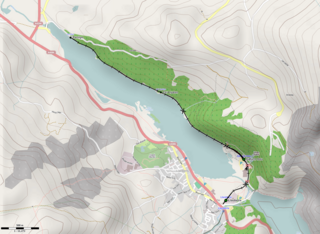
The Llanberis Lake Railway is a 1 ft 11 1⁄2 in narrow gauge heritage railway that runs for 2.5 miles (4 km) along the northern shore of Llyn Padarn in north Wales in the Snowdonia National Park. The starting point is the village of Llanberis at the eastern end of the lake, with the western terminus at Pen Llyn in the Padarn Country Park. The return journey takes around 60 minutes.

The Hollycombe Steam Collection is a collection of steam-powered vehicles, rides and attractions based near Liphook in Hampshire. The collection includes fairground rides, a display farm and two railways.
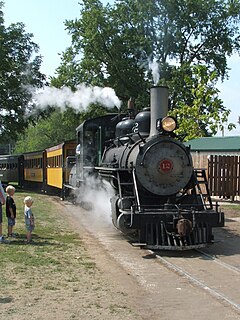
The Midwest Central Railroad is a 3 ft narrow gauge heritage railroad operating within the confines of Mt. Pleasant, Iowa's McMillan Park, site of the Midwest Old Thresher's Reunion. The railroad is a registered, 501(c)(3) non-profit organization. The mainline track is a 1 mile (1.6KM) loop with traffic moving in a clockwise direction regulated by an electrically signaled block system. The mainline loop features 2 stations: at the north end, the original Hillsboro, Iowa, depot along with a Milwaukee Road signal tower; and at the south end, a newer wood frame/metal sided building.
The Garw Valley Railway is the trading name of the Bridgend Valleys Railway Company Limited. It operates a short section of 4 ft 8 1⁄2 instandard gauge railway located in South Wales, which is being recreated as a heritage railway. Formerly part of the Llynvi and Ogmore Railway (L&OR) and built by the Great Western Railway (GWR), the line was used for freight and passenger services, with most of the track still in place between Brynmenyn and Pontycymer. The project currently has a train shed at Pontycymer, and hopes to initially offer brake van rides between Pontycymer and Pant-y-Gog, a distance of 0.5 miles (0.8 km).
The Plynlimon and Hafan Tramway was a 2 ft 3 in gauge narrow gauge railway in Cardiganshire in Mid Wales. It ran from Llanfihangel station on the Cambrian Line, through the village of Tal-y-bont and the valley of the Afon Leri, into the foothills of Plynlimon Fawr. It was built to serve the lead mines at Bwlch Glas and stone quarries around Hafan and opened in 1897, closing just two years later. The line was a little over 7 miles (11 km) long and, despite running a short-lived passenger service, it served no communities of more than 100 people.

Yaxham Light Railway is a 2 ft narrow gauge light railway situated adjacent to Yaxham railway station on the Mid-Norfolk Railway. It is located in the village of Yaxham in the English county of Norfolk.

The Duffield Bank Railway was built by Sir Arthur Percival Heywood in the grounds of his house on a hillside overlooking Duffield, Derbyshire in 1874. Although the Ordnance Survey map circa 1880 does not show the railway itself, it does show two tunnels and two signal posts.
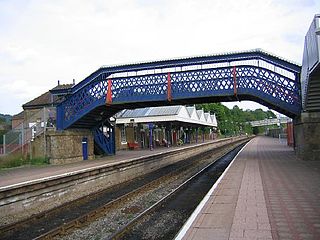
Wendover railway station serves the town of Wendover in Buckinghamshire, England, and villages including Ellesborough and Wendover Dean. The station is on the London Marylebone — Aylesbury line and is served by Chiltern Railways trains. It is between Great Missenden and Stoke Mandeville stations.

The Sand Hutton Light Railway was a minimum gauge estate railway serving the estate of Sir Robert Walker, the Fourth Baronet of Sand Hutton, Yorkshire. It connected the main house with the LNER Warthill Station and the village of Bossall. It replaced the earlier, shorter, 15 in gauge Sand Hutton Miniature Railway that was built in 1914.
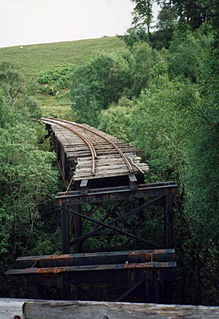
The Lochaber Narrow Gauge Railway was a 3 ft narrow-gauge industrial railway. It was a relatively long line, built for the construction and subsequent maintenance of a 15-mile-long (24-kilometre) tunnel from Loch Treig to a factory near Fort William in Scotland. The tunnel was excavated to carry water for the Lochaber hydroelectric scheme in connection with aluminium production by British Aluminium. The railway came to be known colloquially as the 'Old Puggy Line'.

The Wendover Arm Canal is part of the Grand Union Canal in England, and forms part of the British canal system. It was planned as a feeder to carry water from springs near the town of Wendover in Buckinghamshire to the main line of the Grand Junction Canal at Bulbourne near Star Top End in Hertfordshire, but when it opened in 1799 it was made navigable, as the extra cost of making it so was small. Water supplies from Wendover were found to be inadequate, and a series of reservoirs were built. A pumping station at Whitehouses was superseded by the Tringford pumping station in 1817; its steam engines were replaced by diesel engines in 1911 and then by electric pumps.

The gauge for the most of the China national railway network is standard gauge. Currently, in the national railway network, only the 1,000 mmmetre gauge Kunming–Hai Phong Railway uses narrow gauge. In addition, there are some industrial lines still using narrow gauge, mostly 2 ft 6 in narrow gauge or 600 mm narrow gauge. As of 2003, 600+ km narrow-gauge railways, 50000+ km standard gauge railways, and 9.4 km broad gauge railways were in use in mainland China.
Under the Whyte notation for the classification of steam locomotives by wheel arrangement, a 4-8-2+2-8-4 is a Garratt articulated locomotive consisting of a pair of 4-8-2 engine units back to back, with the boiler and cab suspended between them. The 4-8-2 wheel arrangement has four leading wheels on two axles, usually in a leading bogie, eight powered and coupled driving wheels on four axles and two trailing wheels on one axle, usually in a trailing truck. Since the 4-8-2 type is generally known as a Mountain, the corresponding Garratt type is usually known as a Double Mountain.
The Córdoba and Huatusco Railroad was a 2 ft narrow gauge railway connecting Huatusco with Córdoba. It was opened in 1902 and closed in 1953.
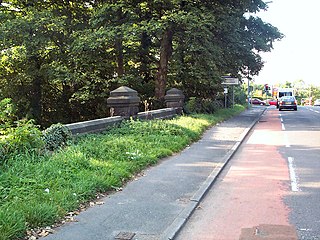
The High Royds Hospital Railway was a short railway connecting the West Riding County Asylum near Leeds in West Yorkshire with the Midland Railway line between Menston and Guiseley on the Otley and Ilkley Joint Railway. The line opened in 1883 and ran for just over 0.5 miles (0.80 km), it was constructed to 4 ft 8 1⁄2 instandard gauge and was a single line throughout. The line closed in the 1930s in the face of road competition and increasing maintenance costs but reopened again in 1939 when the outbreak of war led to a fuel shortage for road transport. Final closure came in 1951.

A launch-type, gunboat or horizontal multitubular boiler is a form of small steam boiler. It consists of a cylindrical horizontal shell with a cylindrical furnace and fire-tubes within this.
Tube-gauge steam locomotives may appear to be an unlikely possibility, because of the problems of using such a machine in the confines of a tunnel less than 12-foot (3.7 m) in diameter, but the London Underground had three such vehicles over the years. Two were built by the Hunslet Engine Company in 1899, and the third by Kerr, Stuart and Company in 1922.

Filey Holiday Camp was a Butlin's holiday camp near Filey, North Yorkshire, England, built for Billy Butlin's holiday organisation. Construction of the camp began in 1939. From 1939 to 1945, the camp was used as a military training base, as RAF Hunmanby Moor.















